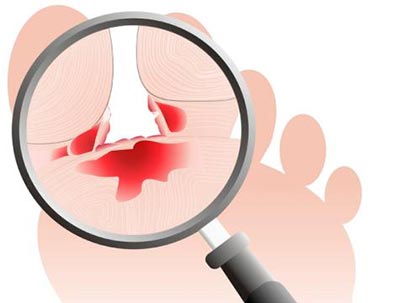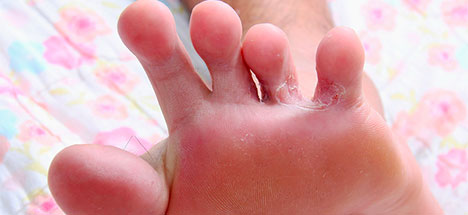Athlete’s Foot
 Athlete’s foot is typically visible as circular white scales on the bottom of the foot and wet skin between the toes.
Athlete’s foot is typically visible as circular white scales on the bottom of the foot and wet skin between the toes.
Athlete’s foot, called tinea pedis, is a contagious skin infection that’s very common in the United States, with an average of three million new cases reported to foot doctor every year. It spreads easily in damp conditions like locker rooms, thus the name “athlete’s foot.” The athlete’s foot is typically visible as circular white scales on the bottom of the foot and wet skin between the toes. Many people attempt to treat athletes’ foot themselves, but treatment from Our Podiatrists, top New York foot doctors, is recommended to ensure successful treatment. All symptoms should always be evaluated with a thorough consultation and examination by your podiatrist for an accurate diagnosis and treatment plan to exclude any underlying serious condition.
Causes
If the fungus gets underneath your toenails, it can cause them to get discolored, crumbly and broken. Athlete’s foot derives from the very same fungus that causes jock itch and ringworm. This condition is caused by a fungus that favors warm and moist conditions such as those found in locker rooms, pools and gyms. Even a tiny flake of infected skin that drops off someone’s foot can spread to you. A leading podiatrist in NYC recommends wearing shoes in all public places. The disease spreads quickly by:
- Direct skin-to-skin contact
- Contact with the fungus on a damp floor
- Using a person’s towel who has the infection
- Sharing shoes
- Sweaty feet that come into contact with the germs
”
★ ★ ★ ★ ★Absolutely wonderful doctor. Very patient, kind, and understanding. I highly recommend if you have any foot/ankle issues.
Signs and Symptoms
The most common symptoms patients report to their podiatry doctor include:
- Dry scaly skin, often between your toes
- Burning and itching sensations
- Peeling skin
- Swelling and inflammation
- Cracked skin
- Blisters
- Itching that worsens when you take off your socks
- Rash that won’t respond to self-care
- Redness
- Drainage
If you are experiencing any of these symptoms you should consult with a foot doctor as other health professionals commonly misdiagnose athlete’s foot. This is because several conditions have similar symptoms including:
- Eczema
- Psoriasis
- Allergic reactions
- Dry skin
All symptoms should always be evaluated with a thorough consultation and examination by your podiatrist for an accurate diagnosis and treatment plan to exclude any underlying serious condition.
Complications
If you are not treated by a qualified professional such as a NYC podiatrist you are at risk for more serious complications such as:
- Bacterial infection
- Spreading infection to others
- Cellulitis
- Infection causing loss of foot in immunicompromized individuals such as those with diabetes.
- Toenail problems. If the fungus gets underneath your toenails, it can cause them to get discolored, crumbly and broken. The nail bed also can become inflamed and swollen, causing significant pain.
- Blood infection – The infection can spread to your blood and lead to organ shut down.
- Jock itch
Foot doctor and leading podiatrist in NYC, typically sees the condition in:
- Men
- People who walk barefoot in public places
- Athletes who share shower stalls and changing areas
- Those who wear tight socks and shoes for long hours
- People who share shoes or clothes
- Those who share towels and linens
- Diabetics
Diagnosis and Treatment

For a mild case of athlete’s foot, your podiatrist may encourage you to use a topical treatment such as a prescription cream. Antifungal pills designed to treat the infection are effective for more severe cases. Very often, a podiatrist can tell that you have developed an athlete’s foot just by examining the appearance of your foot. Remember to tell your foot specialist about any instances where you may have been exposed to the fungus. With examination and knowledge of your recent history, your foot specialist should be able to tell you what treatment protocol you need. To confirm the diagnosis, your podiatry doctor may take small scrapings of skin from your infected area to send to a laboratory for testing.
Prevention:
There are a number of measures which can reduce the risk of athletes foot. Your New York podiatrist recommends
- Cleanliness: Change your socks regularly — twice a day if your feet sweat profusely.
- Protection: Cover your feet in public; use shower slippers or waterproof shoes at public pools, showers and locker rooms at all times.
- Dryness: Dry your feet thoroughly. Foot doctors say this is the one step that many people forget. Take the time to dry between your toes after bathing.
- Ventilation: Wear shoes that are well ventilated. Stay away from shoes that are are rubber and vinyl — they don’t breathe.
- Powder: Apply anti-fungal powder to your feet, especially if you’re susceptible to foot problems.
- Variety: Alternate your shoes; don’t wear the same shoes every day, especially for athletic events.
- Sharing: Avoid sharing shoes or socks with anyone, whether you know them or not; sometimes people don’t even know when they have the early signs of athlete’s foot.
- Sterilize: Use a shoe sterilizer like Lysol if you spend a lot of time in locker rooms.
Regular checkups: Visit a podiatrist NYC regularly if you have a tendency to get athlete’s foot so that they can catch it in the earliest stages when it’s easier to treat.
All symptoms should always be evaluated with a thorough consultation and examination by your podiatrist for an accurate diagnosis and treatment plan to exclude any underlying serious condition.
Important Reminder: This information is only intended to provide guidance, not definitive medical advice. Please consult a foot doctor about your specific condition. Only a trained, experienced podiatrist or foot specialist can determine an accurate diagnosis and proper treatment.
Do you have any questions about Athlete’s Foot prevention or treatment? Would like to schedule an appointment with an internationally recognized, top NYC Podiatrist and foot doctor? Please contact our Manhattan podiatry practice for a consultation.
In The Press

Call now to make an appointment with our award winning, board certified NYC podiatrists regarding your health. We look forward to seeing you!
book online now (212) 389-9918(212) 389-1886 Podiatrist (Midtown) 51 East 25th Street, Ste 451, NY 10010
(212) 389-1887 Podiatrist (Union Square) 55 W 17th St Ste 106, NY 10011
(212) 378-9991
